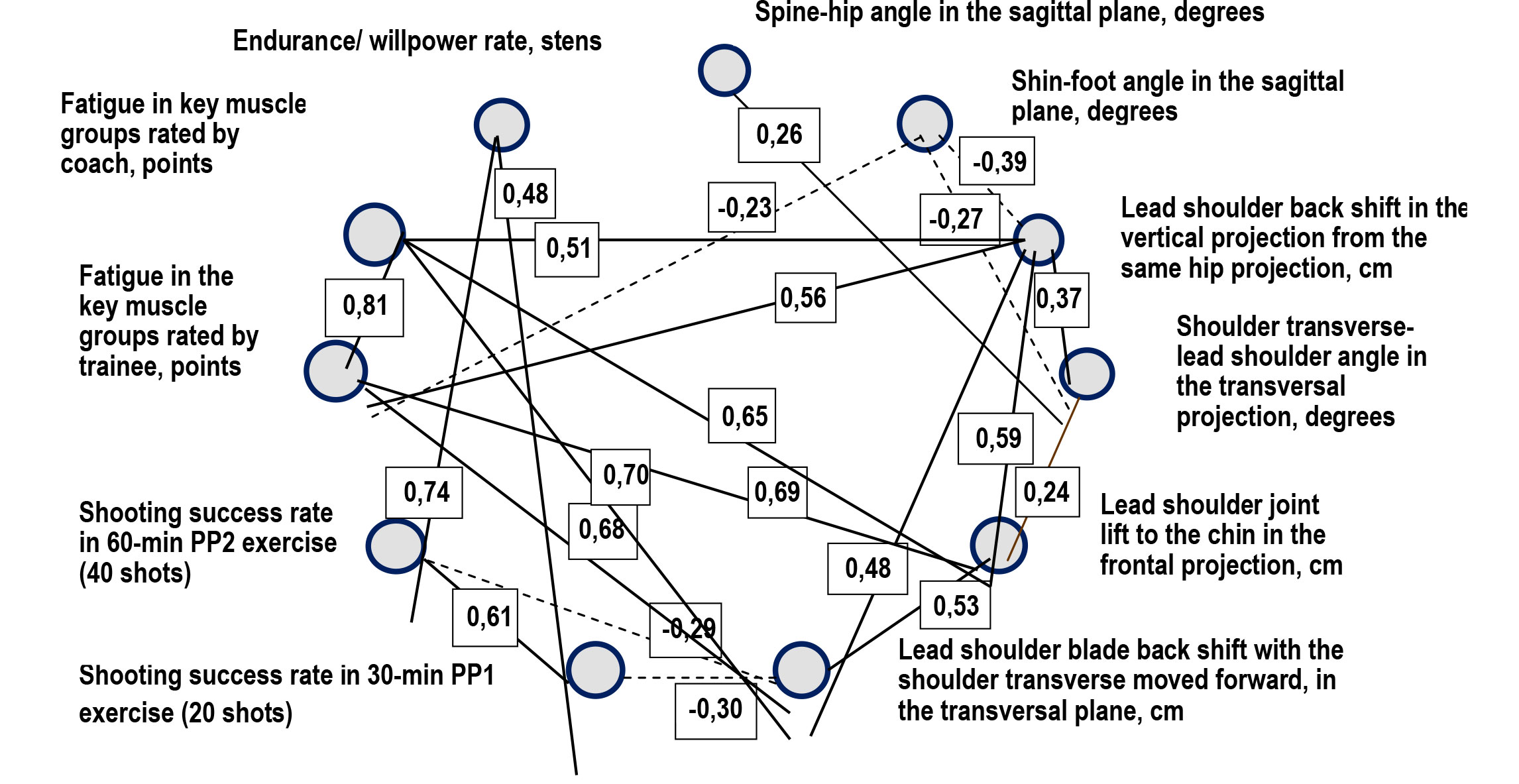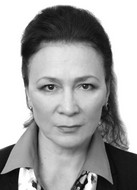Postural control tools to prevent competitive musculoskeletal fatigue in junior rifle shooters
Фотографии:
ˑ:
PhD, Associate Professor G.A. Kuzmenko1
V.V. Shilenok1
1Moscow State University of Education (MSPU), Moscow
Keywords: junior rifle shooters, musculoskeletal system, fatigue, gun-up posture versions, correction.
Background. Competitive success in modern rifle shooting largely depends on the postural control skills to secure the gun-up posture being efficient and ergonomic [1-8].
Objective of the study was to offer and substantiate a set of educational provisions for the performance and postural control balancing practices to control the key muscle groups and mitigate functional imbalances in junior rifle shooters.
Methods and structure of the study. Sampled for the study were junior (13-15 year-old) rifle shooters (n=150) from the Shabolovka Olympic Reserve Sport School; Dynamo Moscow Shooting Sport Club; Moscow Olympic Reserve Sport School #2; Vorobyovy Gory Children and Youth Sport School; Moskvich Olympic Reserve Sport School; and Moscow State Physical Education and Sport Association.
Study findings and discussion. Medical educational analysis of muscular discomfort and functional disorders in the musculoskeletal systems of junior rifle shooters due to the sport-specific postural control stresses made it possible to identify a few postural inefficiency related problems in the context of the sport excellence process requirements and expectations. The medical examinations diagnosed 86% of the sample (n=150) with postural disorders; plus 30% of the sample reported pains in the training and competitive process including: 19.33% reported spinal pains in the lumbar and/or thoracic segments; and 9.33% pains in the limb bones and periosteum. Furthermore, the sampled Masters of Sport were diagnosed with scoliosis, habitual anterior curvatures (up to the saddlebacks in a few cases); and complained having permanent pains in the cervical, thoracic and lumbar spine segments; and some were exposed to flatfoot due to the long-term sport-specific static loads. The sampled Candidate Masters of Sport were diagnosed with habitual anterior curvatures and scoliosis; and many of the sampled Class I and lower-qualified athletes were diagnosed with the habitual anterior curvatures too. In addition, 56% were tested with slouch; and 15% with shoulder joints asymmetry in the frontal plane.
Furthermore, many in the sample were tested with the following disorders in the gun-up posture: shotgun control by an excessively lifted shoulder (that provokes a pain syndrome in the shoulder and elbow joints due to the nerve impingement often associated with an uncontrollable tremor in the gun-holding hand); habitual anterior curvature with the leading shoulder blade pushed forward and upward (up to the saddleback that may even evolve into a hump). When the coaches are negligent to the postural control aspects and postural ergonomics on the whole, the trainees are inevitably exposed to the musculoskeletal system disorders and dysfunctions. This is why it is so important to model the most efficient gun-up posture version(s) to minimize the pain syndrome in the practical training practices: see Figure 1.
When the trainees make progress in the postural control, the shoulder displacements versus the same hip, spinal curvature and shoulder joint lifts are normally minimized. It should also be noted that shooting success is largely determined by the endurance/ willpower that may even hamper the efforts to vary the posture so as to find the most efficient one.

Figure 1. Correlations of the key factors: gun-up posture parameters, shooting success rates and fatigues in the key muscle groups (p<0.05)
The minor negative correlations of fatigue in the key muscle groups with the shin-foot angles may be interpreted as indicative of the postural adjustments due to the insufficient strength fitness of the dorsal extensor muscles. These deficiencies may be counted by the postural control practices with the most efficient gun-up posture being cultivated and maintained.
The experimental rifle shooter training and fatigue control model included a set of special strength-building weight exercises to strengthen the dorsal extensor muscles and abdominal muscles, including yoga practices (dominated by body balancing, static and dynamic exercises). The high-amplitude practices in the model include the flexion-extension exercises in ±3ϭ range in every gun-up posture version – to increase strength of the gun-up posture control muscles. Applied in the training model were also: weight ankle flexion-extension exercises with TRX loops; weight side bends with the stretched/ bent arms; push-ups with widely fixed elbows; arms trainings with TRX loops and dumbbells; rolls from canoe position; prone arms stretching exercises; alligator exercises with TRX loops etc.
The study found the following 3 groups of key factors: (1) gun-up posture ergonomics of influence on the fatigue in the key muscle groups (lead shoulder back shift in the vertical projection from the same hip projection, cm (-0,755); lead shoulder joint lift to the chin in the frontal projection, cm (-0,802); lead shoulder blade back shift with the shoulder transverse moved forward, in the transversal plane, cm (-0,815); fatigue in the key muscle groups rated by trainee, points (-0,860); fatigue in the key muscle groups rated by the coach, points (-0,839); (2) shooting success rate in 30-min PP1 exercise (20 shots) (-0,742); and shooting success rate in 60-min PP2 exercise (40 shots) (-0,840). It should be noted that the above factors were found to correlate with the trainee’s endurance/ willpower rate (-0,874) – since the adolescents tend to stand pain rather than change posture for they believe it is unavoidable for success; and it is the coach’s responsibility to help them master the most efficient gun-up postures and techniques; (3) shoulder transverse - lead shoulder angle in the transversal projection (-0,805). Given in Table 1 hereunder are the parameters of the most common gun-up postures (#1-4) and the less common posture #5.
Table 1. Parameters of the junior rifle shooters’ (n=85) gun-up postures versus the shooting success rates
|
Gun-up posture parameters |
Gun-up posture versions |
||||
|
1 |
2 |
3 |
5 |
4 |
|
|
Spine-hip angle in the sagittal plane, degrees |
3,7 ±1,4 |
4,9 ±1,3 |
2,5 ±1,2 |
3,7 ±2,7 |
6,2 ±5,9 |
|
Shin-foot angle in the sagittal plane, degrees |
99,5 ±10,8 |
90,8 ±5,5 |
109,9 ±25,0 |
89,3 ±6,7 |
114,2 ±11,6 |
|
Lead shoulder back shift in the vertical projection from the same hip projection, cm |
6,6 ±2,1 |
7,5 ±1,4 |
3,6 ±1,4 |
8,2 ±1,6 |
4,0 ±2,6 |
|
Shoulder transverse - lead shoulder angle in the transversal projection, degrees
|
133,5 ±4,6 |
129,8 ±5,1 |
121,7 ±8,4 |
132,3 ±6,1 |
128,4 ±5,1 |
|
Lead shoulder joint lift to the chin in the frontal projection, cm |
8,3 ±3,6 |
6,0 ±3,5 |
3,0 ±1,9 |
6,9 ±2,5 |
1,2 ±0,8 |
|
Lead shoulder blade back shift with the shoulder transverse moved forward, in the transversal plane, cm |
5,9 ±1,3 |
7,6 ±2,2 |
5,5 ±1,1 |
6,6 ±1,5 |
5,1 ±0,8 |
|
Shooting success rate in 30-min PP1 exercise (20 shots), Хср.±ϭ |
169,55 ±9,9 |
164,55 ±11,1 |
170,15 ±9,2 |
170,3 ±10,5 |
170,0 ±9,1 |
|
Shooting success rate in 60-min PP2 exercise (40 shots), Хср.±ϭ |
345,95 ±25,2 |
330,05 ±36,6 |
349,6 ±21,6 |
342,2 ±24,4 |
350,2 ±23,5 |
Conclusion. The study data and analyses showed a fairly wide dispersion of the shooting success rates versus the gun-up posture control parameters, with the highest success rates achievable in every gun-up posture version; albeit the correlations of the gun-up posture parameters with the fatigue rates found by the study give the grounds to recommend the most efficient and healthy versions of the gun-up postural control trainings for this age group.
References
- Emelyanov O.A., Devyataykin N.V. Kak kontrolirovat izgotovku strelka iz pistoleta [Ready position control methods in pistol practice]. Sbornik nauchnykh trudov vserossiyskoy nauchno-prakticheskoy konferentsii (s mezhdunarodnym uchastiem) ‘Aktualnye voprosy sovershenstvovaniya sistemy tekhnicheskogo obespecheniya’ [Proc. Nat. scie.-pract. conf. with internat. Part. ‘Acute issues of improvement of technological infrastructure’]. Perm: Perm Military Institute of National Guard Troops of Russia publ., 2017, pp. 169-171.
- Lubysheva L.I. Zdorovyeformiruyuschaya tehnologiya fizicheskogo vospitaniya mladshikh shkolnikov na osnove traditsionnogo karate [Health forming technology of physical education of primary schoolchildren using traditional karate]. Fizicheskaya kultura: vospitanie, obrazovanie, trenirovka, 2011, no. 3, P. 5.
- Mikhalev V.I., Aikin V.A., Koryagina Yu.V. et al. Sovremennye tendentsii trenirovochnoy i sorevnovatelnoy deyatelnosti v pulevoy strelbe (po materialam zarubezhnoy pechati) [Modern trends of training and competitive activities in rifle shooting (based on foreign press materials)]. Sovremennye problemy nauki i obrazovaniya, 2013, no. 6, P. 223.
- Mishchenko I.A. Chastota i lokalizatsiya narusheniy osanki u strelkov [Frequency and localization of postural problems in shooters]. Adaptivnaya fizicheskaya kultura kak effektivnaya tekhnologiya reabilitatsii i adaptatsii lits s ogranichennymi vozmozhnostyami zdorovya [Adaptive physical education as effective technology for rehabilitation and adaptation of persons with disabilities]. Lipetsk: P.P. Semenov-Tyan-Shansky LSPU publ., 2012, pp. 30-36.
- Pogodin V.A., Ponomarev G.N. Sopryazhennoe sovershenstvovanie koordinatsionnykh sposobnostey sportsmenov-strelkov i ikh tekhnicheskogo masterstva [Competitive shooters' coordination abilities and technical mastery combined excelling model]. Teoriya i praktika fiz. kultury, 2017, no. 4, pp. 75-77.
- Priymakov A.A., Eider E., Omelchuk E.V. Ustoychivost ravnovesiya v vertikalnoy stoyke i upravlenie proizvolnym dvizheniem u sportsmenov-strelkov v protsesse izgotovki i strelby po misheni [Stability of equilibrium in vertical posture and arbitrary movement control in competitive shooters during ready position and target shooting]. Fizicheskoe vospitanie studentov, 2015, no. 1, pp. 36-42.
- Simonenkov V.S., Gilazieva S.R., Shumilina N.S. Obschaya fizicheskaya podgotovka pri obuchenii strelbe studentov vuzov [Body conditioning in university students' shooting training process]. Vestnik Orenburgskogo gosudarstvennogo universiteta, 2017, no. 2 (202), pp. 135-140.
- Shilenok V.V., Kuzmenko G.A. Optimizatsiya parametrov ispolneniya sorevnovatelnogo uprazhneniya yunyimi strelkami-pulevikami na osnove sredstv vospitaniya ustoychivosti v sisteme ‘strelok–oruzhie–mishen’ [Optimization of parameters of competitive exercise performance by junior bullet shooters based on stability building means in 'shooter-weapon-target' system]. Vestnik sportivnoy nauki, 2017, no. 2, pp. 24-30.
Corresponding author: kuzmenkoga2010@yandex.ru
Abstract
Objective of the study was to offer and substantiate a set of educational provisions for the performance and postural control balancing tools to control the key muscle groups in junior rifle shooters. 13-15 year-old rifle shooters were subject to the study. Applied for the study purposes were the educational process monitoring, questionnaire survey, interviews and medical record analyses to detect and analyze the musculoskeletal system imbalances due to the disharmonizing effects of prolonged competitive routines.
The study data and analyses found the statistically significant benefits of a set of special postural control tools designed to minimize the pain syndrome and musculoskeletal fatigue by the following: corrective shifts in the vertical projection of the lead arm backward from the same-side hip joint projection; shifts of the lead arm shoulder joint towards the chin; backward shifts of the shoulder blade with the shoulder cross-line moved forward etc.
A factor analysis found the following key factors of influence: correlation of the gun-up posture control parameters with the muscle-group-specific fatigues; endurance/ willpower factor of the competitive success that, on the negative side of it, forces the adolescents stand pain despite the growing muscular discomfort.
The imbalances detected by the educational process tests demonstrated the need for the competitive performance standards of the junior rifle shooters to be corrected by a set of special physical practices meant to: strengthen the musculoskeletal system; correct the postural control skills with a contribution of the relevant body conditioning tools; build due static/ dynamic balancing skills and special strength abilities by weight flexion-extension/ shifting/ waving practices with ±3s time controls in every version of the gun-up posture.



